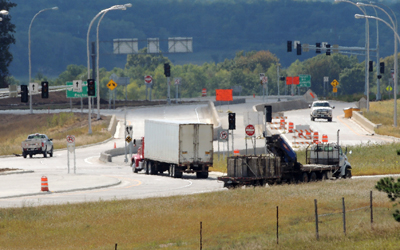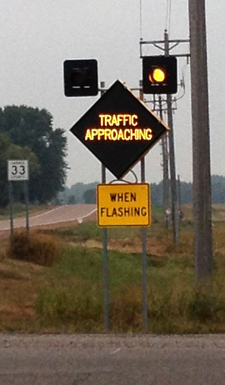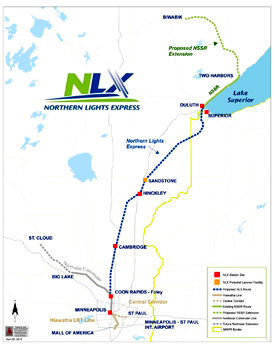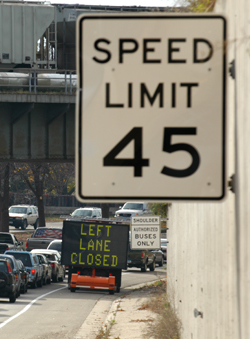 |
|

|
 |
TABLE of CONTENTS
 |
Safety improvements continue on Hwy 52 corridor |
By Kristin Kammueller, District 6 Public Affairs

The Elk Run interchange on Hwy 52, with a diverging diamond interchange, opened to traffic on Sept. 3. Photo by Tory Thompson |
Through the Greater Minnesota Interchange program, TED, SaM and CIMS, Hwy 52 will have four new interchanges by the end of the 2014 construction season.
The Elk Run interchange brings one of the first diverging diamond interchanges to Minnesota. With the DDI design, opposing lanes of traffic crisscross at the ends of the interchange. Traffic signals, signs, pavement markings and concrete barriers guide motorists through the interchange.
The interchange opened to traffic on Tuesday, Sept. 3, along with most of the new frontage road system. The remaining frontage roads are expected to be completed this fall. Once the entire project is complete, 18 at-grade access points will be closed, greatly improving safety along the corridor.
Work on the Cannon Falls interchange began with a groundbreaking ceremony in July. Representatives from the county, city and state were present to celebrate the first step towards the removal of the last two traffic signals along Hwy 52 between Rochester and the Twin Cities.

The new Cannon Falls interchange bridge piers and interchange location uner construction on Hwy 52. Photo by Paul Bissen |
In addition to the grading work, crews are currently setting bridge beams for the new interchange bridge. This work will cause nighttime delays as Hwy 52 will close intermittently for up to 15-minute intervals.
The city of Rochester began constructing the 65th Street interchange this summer. In addition to the new interchange, auxiliary lanes will be constructed on Hwy 52. The new interchange will help relieve some of the congestion on 55th Street during peak travel times.
Next year, work will begin on the Hwy 52 and Goodhue County Road 9 quadrant interchange. The interchange will address a critical safety issue and ensure agricultural equipment crossings. The revised design has fewer environmental impacts than a traditional diamond interchange design and will require less right of way acquisition. |
 |
|

|
 |
TABLE of CONTENTS
 |
MnDOT receives grant for 15 intersection conflict warning systems |
By TK Kramascz

The “Traffic Approaching” signs are part of the conflict warning systems that will be installed at 15 rural, stop-controlled intersections across Minnesota. The warning systems will be installed as part of a $1.45 million federal TIGER grant. Photo by Jon Jackels |
The Transportation Investment Generating Recovery program has awarded a $1.45 million federal grant for the installation of conflict warning systems at 15 rural, stop-controlled intersections across Minnesota. TIGER is part of a federal economic stimulus package administered by the U.S. Department of Transportation.
The warning systems will inform motorists of intersection conflicts ahead to help better judge gaps in traffic. The warning systems are expected to reduce fatal and serious injury crashes on Minnesota roads. This project is the result of an extensive planning effort and is part of Minnesota’s Toward Zero Deaths safety program.
“Intersection conflict warning systems have the potential to significantly reduce collisions and improve safety at rural intersections,” said Sue Mulvihill, deputy commissioner and chief engineer. “Based on the average daily traffic at these intersections, drivers and passengers in more than 80,000 vehicles will experience the added safety and security offered by these systems on a daily basis. This innovative system provides a safe and affordable alternative to traditional traffic safety improvements"
For more information about rural intersection conflict warning systems, visit mndot.gov/trafficeng/signals/conflictwarning.html. This technology is one of many ways MnDOT uses intelligent transportation systems to improve safety on Minnesota’s highways. For more information on Minnesota’s ITS program, visit mndot.gov/guidestar/.
In addition to MnDOT’s award, the Duluth Seaway Port Authority will receive $10 million in TIGER funds to rebuild and expand a general cargo dock and also will fund improvements to existing road and train connections.
Minnesota’s two awards were among $474 million in TIGER grants awarded to 52 projects in 37 states. For more information, see www.dot.gov/tiger/. |
 |
|

|
 |
TABLE of CONTENTS
 |
Northern Lights Express picks up speed |
|
By Mary McFarland Brooks

Proposed route of the Northern Lights Express passenger rail train between the Twin Cities and Duluth. Graphic courtesy of Anoka County |
The Northern Lights Express, a proposed high speed passenger rail service between Minneapolis and Duluth, recently passed an important milestone when the Federal Railroad Administration issued a Finding of No Significant Impact for the Tier 1 Service Level Environmental Assessment. This allows the project to move into the next phase of project development, which includes preliminary engineering and environmental review to analyze the potential impacts of the project.
“The Northern Lights Express will offer a high-speed rail alternative for visitors to Duluth, the Twin Cities and all point’s in-between, including Cambridge and Hinckley,” said Dan Krom, Passenger Rail director.
The proposed service will operate on approximately 155 miles of existing BNSF rail corridor.
With the FONSI in the rear view mirror, some of the next steps for the NLX project include:
- Infrastructure improvements
- Station, layover and maintenance facilities
- Grade crossings
- Environmental documentation
- Ridership and revenue forecasts
- Benefit and cost analysis
- Identification of equipment
- Operating and maintenance plans
- Stakeholder involvement
When built, the NLX will bring back a service that was last available in 1985 when AMTRAK ended 10 years of passenger rail service between the Twin Cities and Duluth.
When preliminary engineering is completed, the project will have all the required documentation and approvals to support final design and construction of the project. This is anticipated to occur between 2018 and 2020 and is dependent on available funding.
Check out the NLX website: www.dot.state.mn.us/nlx/, where you can also sign up for project updates. |
 |
|

|
|

|
 |
TABLE of CONTENTS
 |
Everything you wanted to know about speed limits... and the science behind them |
|
By TK Kramascz

Nathan Drews works with speed limits and crash data in the Office of Traffic, Safety and Technology. Photo by Kelsey Drews |
If you, your family or friends have ever wondered why speed limits exist, how they’re set or whether or not they save lives, Nate Drews has some answers for you. Drews is an expert in speed limits and speed studies from the Office of Traffic, Safety and Technology, where he has worked with speed limits and crash data for 12 years.
The Minn. Statute 169.14 lays it out: speed limits are MnDOT’s responsibility. They’re established to inform drivers of a “reasonable limit” under ideal conditions, making it easier for law enforcement to target unreasonable behavior. The majority of drivers’ observed travel speed is the primary consideration—but it’s only the starting point. Engineering judgment is used to factor in crash experience and roadway hazards.
“Talented personnel from all around the state implement elaborate engineering and traffic investigations in order to determine a proper speed limit,” said Drews. “The speed limit is ‘set’ under authority of the Commissioner of Transportation.”
Drews said changes in driving behavior most often occur when there are substantial changes to a roadway’s design. If driver behavior or roadway design is altered enough, the speed limit may be changed. Most requests to change speed limits come from citizens concerned about safety, but the speed limit itself rarely is the solution.
Speed limits can be separated into two groups—statutory and authorized. Statutory speed limits are in effect even if no signs are present (55 mph in rural areas, 30 mph in town, 10 mph in alleyways) unless otherwise posted with an authorized speed limit. Authorized speed limits require MnDOT to conduct an engineering and traffic investigation and must be authorized by the commissioner.
“There are also other categories including, but not limited to, advisory, school and work zone speed limits,” Drews said.

Speed limits are based upon engineering and traffic investigations by MnDOT employees in the Office of Traffic, Safety and Technology. Photo by David Gonzalez |
A variety of studies performed over the decades show no conclusive evidence that limits of any particular speed cause crashes. Drews said what we do know is that speed variance (i.e., the difference in speed between two or more vehicles) can contribute to more crashes and that crash severity increases as speed increases (more kinetic energy equals greater potential for damage).
“Ideally, if everyone drove at the same rate of speed, no matter the speed, many crashes wouldn’t happen,” Drews said. “Research shows that speed limits standing alone don’t control the speed at which drivers drive, so setting an unrealistic speed limit may introduce greater variance which may lead to more crashes and make everyone a violator, which makes enforcement impossible. Worst yet, it breeds contempt for all speed limits.”
Conversely, setting a speed too high may encourage drivers to “over-drive” the road. The goal of speed limits is to meet driver expectation and discourage unreasonable behavior.
Drews said most people he’s heard from or met with critique engineering practices from an emotional or political viewpoint first before considering the facts, the engineering or any long-term implications.
“It’s always rewarding to see someone who doesn’t understand how and why speed limits are set, suddenly ‘get it’ and leave with a changed viewpoint—or at least have a better overall understanding,” he said. |
 |
|

|
|
| |
|



